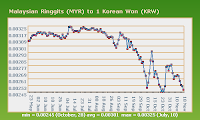Volume is the fuel that drives the market. Charts yield clues when volume is out of character. High turnover on a lower close indicates selling pressure -- people want to get out and no one is eager to buy, so the price falls. High volume on a stronger close indicates buying pressure -- people want to get in, but nobody is willing to sell, so buyers must bid higher.
In this installment that looks into the price/volume dynamic, Charting Asia delves into volume activity reflecting a fast moving rally that, if traded correctly, can deliver good short-term profits for low risk before the rally retreats or moves sideways.
Catch That Rally!
Rally behavior is important as it's often the beginning of a change in the trend from down to up. Unfortunately many people think every rally is the beginning of a new uptrend.
A rally provides a five to ten day trading opportunity and must be managed with a tight stop loss. The way volume increases with price, separates a genuine rally from a skilful example of price manipulation in a 'pump and dump' scheme. It also tells the trader when there's a 'dead cat' bounce. These are the rules.
Recognition rules:
· Stock has a history of good trading volume with well defined rises and falls
(Refer the corresponding charts)
· Volume increases for several days
· Price moves slowly, and then accelerates. This is defined with a parabolic trend, or a trend line
· Volume increases as the price begins to move more quickly











